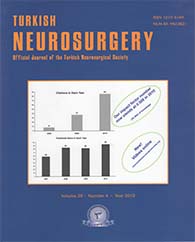Turkish Neurosurgery
2010 , Vol 20 , Num 4
Afyon Kocatepe University, Department of Neurosurgery, Afyonkarahisar, Turkey
DOI :
10.5137/1019-5149.JTN.2591-09.0
Bone wax is primarily used in case of bleeding of the diploic vessels of the bones
in surgical procedures. It is useful in neurosurgical procudores because of its inert,
nonreactive charecteristics. Bone wax is safe material and its use rarely leads to
complications but there may be complications of over use. It can cause direct
pressure of neural tissue as a mass, simulating tumour with the symptoms and on
MRI. In the present case the authors evaluated the signs and syptoms, diagnosis,
surgical treatment, and outcome in a patient with an unusual sequestered mass
simulating a spinal tumour or another space-occupying lesion on preoperative
MR imaging. A 64-year-old was woman admitted to the Neurosurgery Clinic with
a 10 year history of low back pain, 1-year history of gait disorder, leg weakness,
paraparesis, and 1-month history of urinary incontinence and weight loss. T1-
weighted sagittal MRI showed the L3 hemilaminectomy, discectomy defect,
heterogeneous hyperintense extradural mass and spinal stenosis extending from
L2. A hypointense mass relative to the spinal structures was detected in T2-
weighted axial MR images.The provisional diagnosis of a cauda equina syndrome
and intra- or extradural spinal tumour was made. The patient underwent an L2
total laminectomy. In our case the fragment was seen in the epidural space, under
the lamina of L2. The histopathology showed granulation tissue, inflammatory
cells, macrophages and multinuclear giant cells. Postoperatively the patient's
neurological findings recovered quickly and she began to walk more comfortably.
Keywords :
Bone wax, Lumbar disc surgery, Tumour
Corresponding author : H. Selim Karabekır, hskarabekir@hotmail.com





